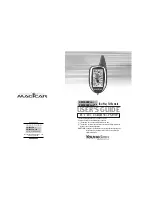
6 of 20
Section B2: Installer
OUTDOOR DESIGN (OUTDR DSGN)
The OUTDR DSGN is the outdoor air temperature that is the typical coldest temperature
of the year where the building is located. This temperature is used when doing the heat
loss calculations for the building. If a cold outdoor design temperature is selected, the
mixing supply temperature rises gradually as the outdoor temperature drops. If a warm
outdoor design temperature is selected, the mixing supply temperature rises rapidly
as the outdoor temperature drops.
SETPOINT OPERATION (MIX TARGET)
For setpoint control, set the OUTDR DSGN to OFF. The MIX TARGET becomes
the setpoint supply temperature that the control is to maintain. The MIX TARGET
temperature is set by the installer in the ADJUST menu. An outdoor sensor is not
required during this mode of operation.
ROOM OCC & UNOCC (ROOM)
The ROOM is the desired room temperature for the mixing zones, and it provides a
parallel shift of the
Characterised Heating Curve
. The room temperature desired by
the occupants is often different from the design indoor temperature (MIX INDR). If the
room temperature is not correct, adjusting the ROOM setting increases or decreases
the amount of heat available to the building. A ROOM setting is available for both the
occupied (Day) and unoccupied (Night) modes.
TERMINAL UNITS (HEAT EMITTERS)
When using a
Characterised Heating Curve
, the control requires the selection of a terminal unit (heat emitter). The terminal
unit (heat emitter) determines the shape of the
Characterised Heating Curve
according to how the terminal unit (heat emitter)
delivers heat into the building space. The GEO 360 provides for selection between six different terminal unit (heat emitter) types:
two types of underfloor heating, fan heater, fin-tube convector, radiator, and baseboard. When a terminal unit (heat emitter)
is selected, the control automatically loads the design supply temperature (MIX DSGN), maximum supply temperature (MIX
MAX) and minimum supply temperature (MIX MIN). The factory defaults are listed below. To change defaults, refer to section
B3. If a default has been changed, refer to Section A to reload the factory defaults. If using more than one type of terminal unit
(heat emitter), then make a selection based upon the greater number of terminal units (heat emitters) of single type.
Underfloor Heating Screeded (1)
This type of a underfloor heating is embedded in a thick concrete slab. This heating
system has a large thermal mass and is slow acting.
Default values: MIX DSGN = 45°C, MIX MAX = 55°C, MIX MIN = OFF
Underfloor Heating Plated (2)
This type of underfloor heating system is either attached to the bottom of a wood
sub-floor, suspended in the joist space, or sandwiched between the sub-floor and
the surface. This type of heating system has a relatively low thermal mass and
responds faster than a high mass system.
Default values: MIX DSGN = 55°C, MIX MAX = 65°C, MIX MIN = OFF
Fan Heater (3)
A fan heater or air handling unit (AHU) consists of a finned heat exchanger and
either a fan or blower. Air is forced across the coil at a constant velocity by the fan
or blower, and is then delivered into the building space.
Default values: MIX DSGN = 85°C, MIX MAX = 100°C, MIX MIN = 40°C
Decreasing Outdoor Temperature
Incr
easing W
a
ter T
e
mperatur
e
MIX DSGN
MIX DSGN
Mix INDR
Mix INDR
OUTDR
DSGN
OUTDR
DSGN
Cold
Cold
Warm
Warm
Decreasing Outdoor Temperature
Incr
easing W
a
ter T
e
mperatur
e
ROOM
ROOM
MIX INDR
MIX INDR
A
c
tu
al
T
em
pe
r
a
t
u
re
N
or
m
al
De
si
gn
TERMINAL UNIT
(HEAT EMITTER)
Underfl oor Heating
Screeded (1)
Underfl oor Heating
Plated (2)
Fan Heater
(3)
Fin-Tube
Convector (4)
Radiator
(5)
Baseboard
(6)
MIX DSGN
45°C
55°C
85°C
80°C
80°C
65°C
MIX MAX
55°C
65°C
100°C
90°C
85°C
80°C
MIX MIN
OFF
OFF
40°C
OFF
OFF
OFF








































